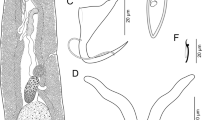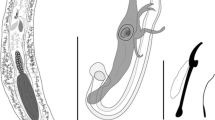Abstract
Description, figures and metric data on the main diagnostic criteria are given for Dactylogyrus ostraviensis n. sp., an organism parasitizing the gills of Barbus conchonius in aquarium conditions. The shape of the hard parts of the haptor, particularly the ventral bar and the main part of the inner roots of the anchors and also the copulatory organ, differ from those in previously described species parasitizing freshwater fishes of the Old World.
Similar content being viewed by others
References
Frank, S. (1972) [The large geography book of fish.] Prague: Artia, 558 pp. [In Czech.].
Gusev, A.V. (1963) New species of Monogenoidea from fishes of Ceylon. Bulletin. Fisheries Research Station, Department of Fisheries, Ceylon, 16 (1), 53–93.
Gusev, A.V. (1976) Freshwater Indian Monogenoidea. Principles of systematics and their evolution. Indian Journal of Helminthology 25 & 26, 1–241.
Gusev, A.V. (1978) [Monogenoidea of freshwater fishes. Principles of systematics, analysis of world fauna and his evolution]. Parazitologicheskii Sbornik, 27, 96–198 [In Russian].
Gusev, A.V. (1985) [Parasitic metazoa (first part)]. In: Bauer, O.N. (Ed.) [Key to the parasites of freshwater fish of the USSR Vol. 2]. Leningrad Izdatelstvo ‘Nauka’, 425 pp. [In Russian].
Kulwiec, Z. (1927) Untersuchungen an Arten des genus Dactylogyrus Diesing. bulletin de l'Academie Polonaise des Sciences et des Lettres, (1927), 113–144.
Lim, L.H.S. & Furtado, J.I. (1986) Sixteen new species of Dactylogyrus from the genus Puntius Hamilton (Cyprinidae). Folia Parasitologica, 33 21–34.
Lucký, Z. (1970a) Dactylogyrus sekerai n. sp. on the gills of Puntius schuberti Acta Veterinaria Brno, suppl. 1, 7–11.
Lucký, Z. (1970b) Dactylogyrus volfi n. sp. on the gills of the aquarium species Puntius tetrazona. Acta Veterinaria, Brno, 39, 165–169.
Mashego, S.N. (1983) South African monogenetic parasites of the genus Dactylogyrus: new species and records (Dactylogyridae: Monogenea). Annals of the Transvaal Museum, 33 337–346.
Paperna, I. (1973) New species of Monogenea (Vermes) from African freshwater fish. A preliminary report. Revue de Zoologie et de Botanique Africaine, 87, 505–518.
Paperna, I. (1979) Monogenea of inland water fish in Africa. Annales Musée Royal de l'Afrique Central, Serie Sciences Zoologiques, 226, 1–131.
Paperna, I. & Thurston, J.P. (1968) Monogenetic trematodes (Dactylogyridae) from fish in Uganda. Revue de Zoologie et de Botanique Africaines, 79, 284–294.
Price, C.E. & Géry, J. (1968) Parasites de poissons du Gabon. Généralités sur les trematodes monogénétiques, et description de six nouvelles espéces parasites du genre Barbus. Biologia Gabonica, 4, 83–103.
Riehl, R. & Baensch, H.A. (1984) Aquarien Atlas. Melle: Mergus-Verlag für Natur-und Heimtierkunde, 992 pp.
Sterba, G. (1972) [Aquarism]. Prague: Nakl. Práce, 367 pp. [In Czech.]
Author information
Authors and Affiliations
Rights and permissions
About this article
Cite this article
Rehulka, J. Dactylogyrus ostraviensis n. sp. (Dactylogyridae: Monogenea) from the gills of Barbus conchonius . Syst Parasitol 12, 77–80 (1988). https://doi.org/10.1007/BF00182030
Accepted:
Issue Date:
DOI: https://doi.org/10.1007/BF00182030




